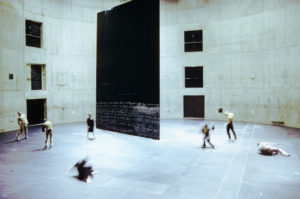
For the English version, please, scroll down.
Dal 6 al 9 dicembre, presso il teatro Haus der Berliner Festspile, è andato in scena Körper, uno dei capolavori della danza contemporanea firmato dalla coreografa tedesca Sasha Waltz.
L’aspetto più interessante della performance dello scorso fine settimana è stato vedere interpretare quest’opera così rappresentativa del repertorio della Sasha Waltz & Guests da un cast parzialmente diverso dall’originale.
Avendo già visto e amato questo bellissimo spettacolo provocatorio e intenso, è stato interessante osservare come sia rimasto assolutamente riconoscibile lo stile nonché il senso profondo di questo lavoro che, attraverso immagini talvolta drammatiche, talvolta ironiche, talvolta finanche surrealistiche, affronta delicatissimi temi etici e sociali relativi al corpo.
Sin dal principio ho ricevuto le risposte che cercavo.
L’impronta del lavoro della coreografa tedesca è più importante della personalità dei singoli bravissimi danzatori, tanto che la danza iniziale, fatta di un contact fluido e dinamico che fa viaggiare i corpi nello spazio attraverso prese, ganci, leve e spinte, conserva la qualità tipica della danza della compagnia, tanto da ricordare Travelogue twenty to eight o Allee der Kosmonauten.
Poi tutto scorre come nei miei ricordi: dalla parete nera del grande muro eretto al centro del palco spoglio, fuoriescono singole parti di corpo senza identità. Una gamba muscolosa, capelli lunghi, dita affusolate, un robusto braccio maschile, fanno capolino dalle piccole fessure aperte sul muro e poi spariscono all’improvviso.
Nella grande finestra al centro della stessa parete, corpi si adagiano morbidi l’uno sull’altro. Altri, leggeri – come in assenza di gravità – scendono dall’alto e altri corpi ancora, sinuosi, compaiono dai lati della cornice che delimita la teca illuminata. Come in un quadro continuamente in movimento sembra a tratti di scorgere La Deposizione del Pontormo, o una scena del Giudizio Universale di Michelangelo.
Personaggi con una storia si alternano sul palco raccontando aneddoti relativi a parti del loro corpo a cui si riferiscono sempre usando nomi di altre parti del corpo.
Due donne vendono i loro organi gridandone prezzi, mentre altri danzatori a mo’ di cavie di laboratorio, vengono spostati di peso, capovolti, svuotati e sezionati.
Poi di nuovo si cambia prospettiva, e con essa il modo di riferirsi e di guardare i corpi.
Deformi centauri tutti umani – la parte posteriore di un corpo ha l’orientamento opposto del suo busto – si spostano sul palco con goffe camminate. Mille sollecitazioni visive catturano lo spettatore, tutti i danzatori si muovono sul palco, c’è persino uno sciatore che si lancia giù dalla cima del muro, tanto che diventa difficile decidere quale immagine privilegiare.
Infine il muro cade e qualcosa cambia.
Cambia l’atmosfera della rappresentazione e la disposizione dei danzatori sul palco. Prima tutto era caotico, ora greve e geometrico. I corpi sono allineati, si muovono come la lancetta di un orologio, poi lungo il bordo del muro, ora diventato una grande pedana inclinata, si sistemano come pesanti sacchi di juta, e ancora in fila, per terra, come su un binario.
Fino agli applausi finali che richiamano sul palco i danzatori molte
volte.
Come le più celebri sinfonie o le più belle sculture del rinascimento, Körper si conferma uno spettacolo magnifico, una vera opera d’arte contemporanea da vedere e rivedere per comprenderne più a fondo il significato e cogliere sempre nuovi interessanti particolari.


From December 6th to 9th , at the Haus der Berliner Festspile theater, Körper – a masterpiece of contemporary dance by the German choreographer Sasha Waltz – was on.
The most interesting aspect of last weekend’s performance was to see this strongly representative opera by Sasha Waltz & Guests repertoire, executed by a partially different cast from the original.
Having already seen and loved this provocative and intense show, it was interesting to observe how, despite the change, the style and profound sense of this work remained absolutely recognizable. An unforgettable piece, that through sometimes dramatic, sometimes ironic, sometimes even surrealistic images, deals with very delicate ethical and social themes about the body.
From the beginning I got the answers I was looking for.
The imprint of the German choreographer’s work is more important than the personality of the individual talented dancers. The initial dance, made of a fluid and dynamic contact that makes the bodies travel in the space through sockets, hooks, levers and thrusts, preserves the typical dance quality of the German choreographer. It even makes you remember Travelogue twenty to eight or Allee der Kosmonauten.
Then, everything flows as in my memories: from the black facade of the great wall erected in the center of the bare stage, body parts without any identity appear. One muscular leg, some long hair, tapered fingers, a strong man’s arm peep from small slits in the wall and then suddenly disappear.
In the large cell/window at the center of the same wall, soft bodies recline on one another. More bodies, lightly descend from above and yet more, sinuous forms appear from the sides of the border around the illuminated display case. Like a constantly moving picture, at times seems like The Deposition by Pontormo, or like a scene from the Last Judgment by Michelangelo.
Characters with a story alternate on stage telling anecdotes related to their body parts, to which they refer, always using the names of other different body parts.
Two women sell their own organs by screaming the prices of each one of them, whilst other dancers, like laboratory animals, are moved by weight, turned upside down, emptied and dissected.
Then the perspective changes again, and with it, the way of watching and referring to the bodies.
Deformed centaurs – entirely human – with the back part of the body facing the opposite direction of its torso, move on stage with clumsy walk. Thousands of visual stimuli capture the audience; all the dancers move on stage, there’s even a skier who jumps down from the top of the wall, to the point that it becomes difficult to decide which image to focus on.
Finally, the wall falls and something changes.
The atmosphere of the representation changes as it does the disposition of the dancers on stage. Before, everything was chaotic, now it becomes heavy and geometric. The bodies are aligned, they move like the hand of a clock, then, along the edge of the wall (which has become a large sloping platform) they arrange themselves as if they were heavy jute bags, and again in a row, on the ground, like on platform of a train station.
And then, the final applause comes, calling the dancers back on stage several times.
As the most famous symphonies or the most beautiful sculptures of the Renaissance, Körper confirms itself as a magnificent spectacle, a true work of contemporary art to watch and review in order to understand its meaning more deeply and always catch new interesting details.














































